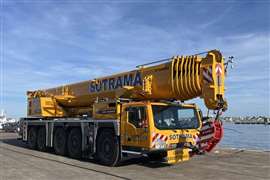Read this article in Français Deutsch Italiano Português Español
Addressing growing mental health concerns in construction
18 January 2024
According to the research firm Construction Industry Round Table (CIRT), there are between 8 and 12 million people employed in the U.S. construction industry. Around 90 percent of them are men. And around 83 percent of them have struggled with mental health issues.
 Photo: www.humanfocus.co.uk
Photo: www.humanfocus.co.uk
This isn’t new information, unfortunately. The construction industry is high-stress and physically demanding – often perceived as a “tough-guy” profession where you have to hide injuries, emotions, anxiety. As a result, depression and/or substance abuse is commonplace, and worse, the industry ranks second among all industries in suicide rate – twice the rate for civilian working men.
A logical question would be: how do we course-correct?
Obviously, construction doesn’t hold exclusive rights on any of the above, and mental health doesn’t discriminate among professions. But it is very important to recognize what’s happening in our own industries – and endeavor to help the people who struggle, with an eye towards alleviating the reasons they do.
Recognizing that many people (especially men) in this industry hesitate to seek help due to the stigma surrounding mental health and the perception that seeking help is a sign of weakness, we as leaders need to acknowledge that addressing this issue will require a multifaceted and collaborative approach involving employers, workers, industry stakeholders and mental health professionals.
Wider access
First and foremost, raise awareness and normalize conversations. Conduct workshops and training sessions about mental health issues specific to the construction industry. Share success stories of individuals who have overcome related challenges. Encourage open discussions about mental health to reduce stigma. And probably most important, train managers and supervisors to recognize signs of mental health issues and create a supportive environment for employees to speak up.
Another thing that often gets overlooked in the busy-ness of our jobs and lives is basic education. We almost certainly don’t talk enough or even educate ourselves enough about stress management, coping mechanisms and mental health resources. But even a little effort to ensure that all employees are informed about available mental health services and resources can go a long way. Mostly because we simply can’t know who is ultimately going through what type of challenge, often mostly alone.
Similarly, establishing employee assistance programs that provide confidential counseling services can work wonders. And in-house, cultivating a sense of community by creating support groups or networks for employees to share experiences and coping strategies can be both effective and rewarding. If the opportunity presents itself, leaders might even consider openly sharing their own experiences and demonstrating a commitment to improving their own mental health – which could likely encourage others to seek help without fear of judgment.
Drilling down, perhaps flexible work arrangements make sense, given certain scenarios. Remote work or adjusted hours could very well reduce stress and improve the balance for certain people and situations. Either way, make a point of conducting regular health check-ins with employees to assess their mental and emotional well-being. And encourage open dialogue during these check-ins to identify potential issues early on. Getting out in front of some of these challenges is often the most effective way to not just work through them, but potentially stop them from ever fully forming.
More broadly, companies can collaborate with external mental health support networks and organizations to ensure that employees have access to a wide range of resources.
At the end of the day, by taking these proactive measures, we can not only support and uplift our own people, but together, the industry can foster a healthier and more productive workforce while also improving the overall wellbeing of construction professionals. At a time when we need it most.
STAY CONNECTED


Receive the information you need when you need it through our world-leading magazines, newsletters and daily briefings.
CONNECT WITH THE TEAM












